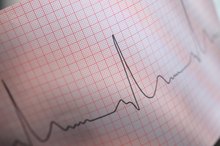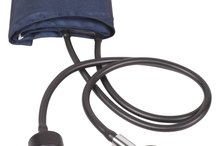Alternative to Metoprolol Succinate
Metoprolol succinate is an extended-release version of metoprolol. This drug is a beta blocker that is used to treat high blood pressure and other heart conditions. While many patients can take this drug with no problems, an alternative to metoprolol succinate may be needed if it does not control blood pressure adequately or causes unpleasant side effects.
If you are experiencing serious medical symptoms, seek emergency treatment immediately.
Beta Blockers
Metoprolol succinate is just one of many drugs known as beta blockers. These medications block the effects of epinephrine on the heart, which slows the heartbeat and reduces blood pressure. These drugs also improve blood flow, reducing the force of the heartbeat. If metoprolol succinate is not effective, other beta blockers may be used to control blood pressure. Examples of beta blockers include bisoprolol, atenolol and propranolol.
- Metoprolol succinate is just one of many drugs known as beta blockers.
- These medications block the effects of epinephrine on the heart, which slows the heartbeat and reduces blood pressure.
Calcium Channel Blockers
Losartan Alternatives
Learn More
Calcium channel blockers relax the blood vessels and reduce the pumping strength of the heart 1. In addition to treating high blood pressure, these drugs can also be used to treat heart arrhythmia and chest pain. Those with heart failure or with structural damage to their heart muscles should avoid calcium channel blockers 1. Examples of calcium channel blockers include verapamil, diltiazem and nifedipine 1.
ACE Inhibitors
ACE inhibitors, also known as angiotensin-converting enzyme inhibitors, are used to treat hypertension and heart failure. This type of drug may also be used to slow kidney failure in diabetic patients. ACE inhibitors work by preventing an enzyme from narrowing the blood vessels and releasing hormones that contribute to an increase in blood pressure. When the blood vessels are relaxed, the heart can beat with less force, reducing blood pressure. Examples of ACE inhibitors include lisinopril, captopril, enalapril, fosinopril and quinapril.
- ACE inhibitors, also known as angiotensin-converting enzyme inhibitors, are used to treat hypertension and heart failure.
- ACE inhibitors work by preventing an enzyme from narrowing the blood vessels and releasing hormones that contribute to an increase in blood pressure.
Diuretics
High Blood Pressure Medications Without Side Effect of Coughing
Learn More
Diuretics are used to treat high blood pressure and congestive heart failure. They reduce the amount of water in the body by working with the kidneys to increase the amount of urine that is produced. The three types of diuretics are loop diuretics, thiazide diuretics and potassium-sparing diuretics. All three types relax the blood vessels and reduce cardiac output and blood volume. Patients who are taking loop or thiazide diuretics need to consume adequate amounts of potassium, as increased urine production can cause a reduced potassium level in the body. Examples of diuretic drugs include hydrochlorothiazide, furosemide and amiloride.
- Diuretics are used to treat high blood pressure and congestive heart failure.
- Patients who are taking loop or thiazide diuretics need to consume adequate amounts of potassium, as increased urine production can cause a reduced potassium level in the body.
Related Articles
References
- American Heart Association: Calcium Channel Blockers
- Calcium channel blockers in the management of stable angina pectoris. April 2019.
- Ghosh D, Syed AU, Prada MP, et al. Calcium channels in vascular smooth muscle. Adv Pharmacol. 2017;78:49-87. doi:10.1016/bs.apha.2016.08.002
- American Heart Association. Conduction disorders. Updated September 30, 2016.
- Godfraind T. Discovery and development of calcium channel blockers. Front Pharmacol. 2017;8:286. doi: 10.3389/fphar.2017.00286
- Humbert X, Roule V, Milliez P, Alexandre J. Verapamil and vasospastic angina: underuse in the elderly population. J Geriatr Cardiol. 2017;14(7):430-435. doi:10.11909/j.issn.1671-5411.2017.07.004
- Sica DA. Current concepts of pharmacotherapy in hypertension: combination calcium channel blocker therapy in the treatment of hypertension. J Clin Hypertens (Greenwich). 2001;3(5):322-7. doi:10.1111/j.1524-6175.2001.00484.x
- Sica DA. Current concepts of pharmacotherapy in hypertension: combination calcium channel blocker therapy in the treatment of hypertension. J Clin Hypertens (Greenwich). 2001;3(5):322-7. doi:10.1111/j.1524-6175.2001.00484.x
- Gersh BJ, Maron BJ, Bonow RO, et al. 2011 ACCF/AHA guideline for the diagnosis and treatment of hypertrophic cardiomyopathy: executive summary: a report of the American College of Cardiology Foundation/American Heart Association Task Force on Practice Guidelines. Circulation. 2011;124(24):2761-96. doi:10.1161/CIR.0b013e318223e230
- Haller H. Effective management of hypertension with dihydropyridine calcium channel blocker-based combination therapy in patients at high cardiovascular risk. Int J Clin Pract. 2008;62(5):781-90. doi:10.1111/j.1742-1241.2008.01713.x
- Oregon Evidence-based Practice Center Oregon Health & Science University. Drug class review on calcium channel blockers. Updated June 2004.
- Cleveland Clinic. Hypertrophic cardiomyopathy guide. Updated May 2009.
- NIH MedlinePlus. Verapamil. Updated October 15, 2017.
- NIH MedlinePlus. Diltiazem. Updated October 15, 2017.
- Ioulios P, Charalampos M, Efrossini T. The spectrum of cutaneous reactions associated with calcium antagonists: a review of the literature and the possible etiopathogenic mechanisms. Dermatol Online J. 2003;9(5):6.
- McKeever RG, Hamilton RJ. Calcium Channel Blockers. In: StatPearls [Internet]. Updated March 29, 2020.
- Fihn SD, Gardin JM, Abrams J, et al. 2012 ACCF/AHA/ACP/AATS/PCNA/SCAI/STS Guideline for the Diagnosis and Management ofPpatients with Stable Ischemic Heart Disease: a Report of the American College of Cardiology Foundation/American Heart Association task force on practice guidelines, and the American College of Physicians, American Association for Thoracic Surgery, Preventive Cardiovascular Nurses Association, Society for Cardiovascular Angiography and Interventions, and Society of Thoracic Surgeons. Circulation 2012; 126:e354.
- Gersh BJ, Maron BJ, Bonow RO, et al. 2011 ACCF/AHA Guideline for the Diagnosis and Treatment of Hypertrophic Cardiomyopathy: Executive Summary: a Report of the American College of Cardiology Foundation/American Heart Association Task Force on Practice Guidelines. Circulation 2011; 124:2761.
- James PA, Oparil S, Carter BL, et al. 2014 Evidence-Based Guideline For The Management Of High Blood Pressure In Adults: Report From The Panel Members Appointed to the Eighth Joint National Committee (JNC 8). JAMA 2014; 311:507.doi: 10.1001/jama.2013.28442
Writer Bio
Leigh Zaykoski has been a writer and editor for six years. Her medical writing has appeared on dozens of websites. Zaykoski attended the University of Pittsburgh and Keystone College, studying microbiology and business administration. She is currently pursuing a medical writing certification.







